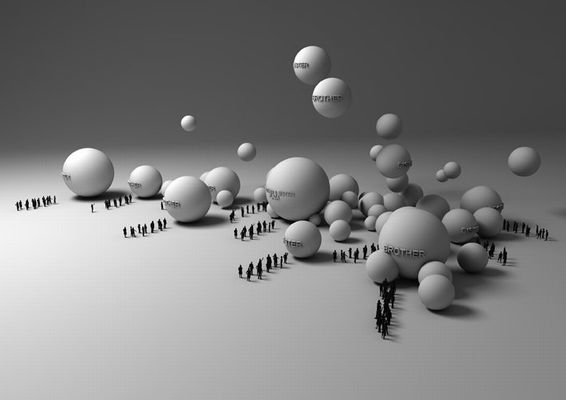Traveling is increasingly becoming an essential element of being an artist. Present-day art climate expects a successful artist to travel all over the world for exhibitions, residencies and fairs. Origin and roots, on the other hand, or perhaps because thereof, seem to play an increasingly larger role in the process of creating. The artists tell their own story, sometimes in a direct way, sometimes only dropping a hint here and there, but always present. Through their view on New York, Shanghai, Tel Aviv, Texas and Zagreb the artists give in Places To Be a view on their background.
Alicia Framis (1967) moved two years ago from her native town in Spain to Shanghai, with more than 17 million inhabitants China's largest city. In New Buildings for China, a series of works consisting of scale-models and 3D computer drawings, Framis refers in a direct and penetrating way to social issues of contemporary China, such as the single-child policy, implemented by the Chinese government in 1979 in Brothers and Sisters, Shanghai, or growing alcoholism in urban areas in cynical AA bar.
David Maljkovic (1973) on the other hand is concentrating on the past of his place of residence, Zagreb, and its inhabitants. In the installation From Lost Review he is referring to the Zagreb Fair, in the sixties and seventies the icon of economic and cultural bloom, the very picture of optimism. Maljkovic combines in his collages photos and text from brochures from that prime, with images of the desolate fair site now. He creates herewith a picture of the collective loss of optimism, the emptiness of the pavilions as a symbol for a country's failure. Simultaneously, David Maljkovic is looking for possibilities of a new beginning for his own generation.
Yael Bartana (1970) is looking for new opportunities for the Israelis and Palestinians of her generation. In her new series of photographs The Missing Negatives of the Sonnenfeld Collection she breathes new life into the collection of photographs of legendary Leni and Herbert Sonnenfeld. The Sonnenfeld photos, taken in Palestine in the thirties, have gone down in the world as icons of the optimistic building of a new state. In that same communistic, propagandistic style Yael Bartana portrays both Jews and Palestinians in a kibbutz in Tel Aviv, jointly building a utopist place without any war.
Carla Klein (1970), Contrary to David Maljkovic and Yael Bartana, shows a desire for traveling, letting go of one's roots. In an almost filmic series of paintings she paints her journey through the Texan landscape. Not, as often depicted, in the drought of summer, but in a rainy, threatening winter. The emptiness of the landscape, the desolation of the highway with occasionally a traffic light or a car, is the subject of the series. At the same time Carla Klein paints the journey itself, the outlandish places surface as beacons in her oeuvre.
Chemi Rosado Seijo (1973) is playing with the characteristics of the big city. In To TT Pollock he portrays New York City in the form of tracks of skateboarding youngsters, referring in a playful way to Pollock's 'action painting'. Himself a fervent skateboarder, Chemi Rosado Seijo produced in New York the project History on Wheels, a series of photos of all squares, stairs and ramps that are perfect for skateboarding, with the objective to map the city from that point of view. At the same time he created interaction with an entire subculture that normally keeps aloof from the elitist arts. His studio at Art in General, where he had a residency, was transformed into a hang-out for skateboarders from all over the city. To TT Pollock is the reproduction of this meeting point, and a tribute to the urban landscape.
Opening Hours
tuesday to friday 10am- 6pm
saterday 1-6 pm
More information on the Annet Gelink website
